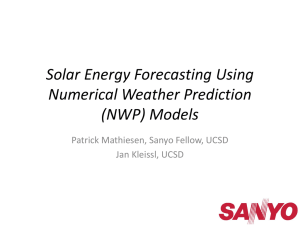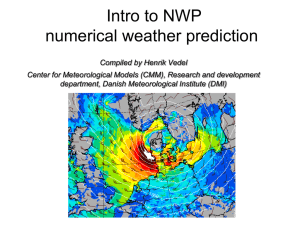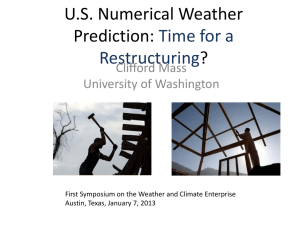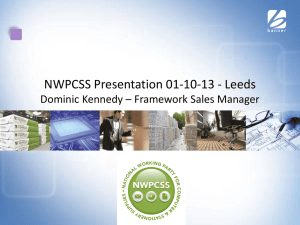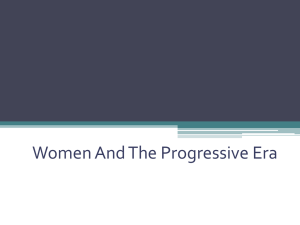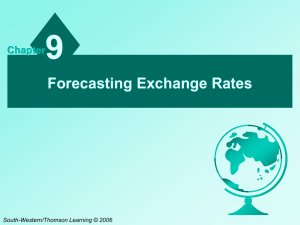New Training Course on Use of NWP in Forecast Operations
advertisement
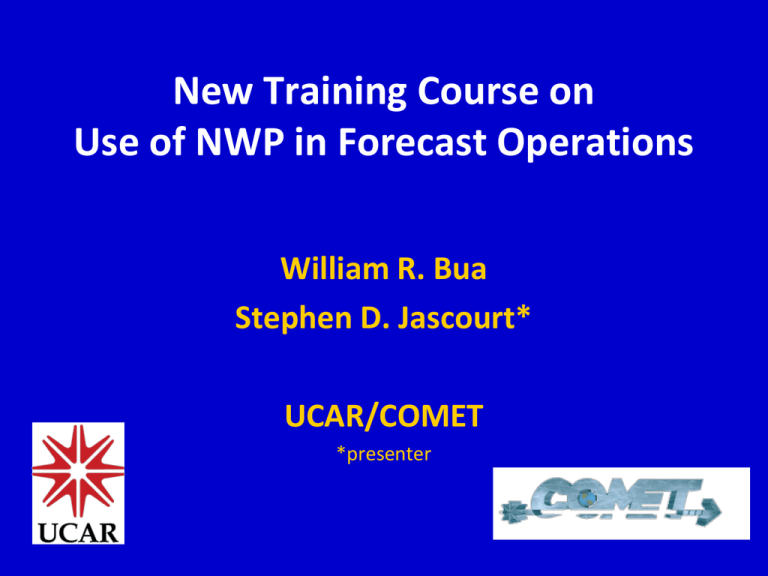
New Training Course on Use of NWP in Forecast Operations William R. Bua Stephen D. Jascourt* UCAR/COMET *presenter Outline 1. 2. 3. 4. 5. Existing COMET NWP Training NWP Training Needs for Forecasters Course Design Course Content Overview Conclusion Existing COMET NWP Training Oriented toward operational forecaster Free, publicly available: www.meted.ucar.edu Existing COMET NWP Training Oriented toward operational forecaster Free, publicly available: www.meted.ucar.edu Existing COMET NWP Training Oriented toward operational forecaster Free, publicly available: www.meted.ucar.edu • Course on fundamentals of NWP (1999-2000) • Reference matrix on current models – parameterizations, terrain, layers, assimilated data, … – ensemble configurations • Modules (NAM-WRF, ensemble basics, RTMA, etc.) • Mini-cases (mostly old) • VISITview Teletraining archives Focus mostly model concepts and specific models Need more on use in forecast context NWP Training Needs for Forecasters Survey (JP4.5) of NWS SOOs and Scientific Service Divisions Identified 4 main categories: • Forecast process (pay attention to observations, analyze/think!) • Core model topics (bias, diagostics, what’s in the model, etc..) • Uncertainty/probabilistic (focusing heavily on use of ensembles) • Local-scale forecasting (high-resolution models, downscaling, etc.) Identified priority topics: • Using NWP to assess forecast uncertainty, probabilistic NWP • Using NWP for mesoscale prediction • Using NWP in preparing 5-km and 2.5-km forecast grids Course Design Design: ~ NWS/WDTB Advanced Warning Operations Course • 1-page consolidated user interface • Subject Matter Experts content and organization • Individual lessons grouped into units • Practical application on Weather Event Simulator (WDTB help) • Quiz for credit: each lesson, certificate upon completing a unit Instructional Designers: Lessons = Lectures New Course 1) Update old course 2) Continue providing model-specific information 3) New units on use of NWP in forecast process Course Content Overview Unit 1: Orientation brief 2009 Unit 2: NWP Basics includes updated, trimmed old course 2009 Unit 3: Using and Adding Value to NWP in the Forecast Process 2009 Unit 4: Special Forecast Problems (terrain, coastal, convection, …) 2010 Unit 5: NWP Use in Gridded Forecast Generation 2010 Unit 6: Emerging future topics 2011+ Course Content Overview Unit 1: Orientation brief 2009 2011+ Unit 2: NWP Basics includes updated, trimmed old course 2009 2011+ Unit 3: Using and Adding Value to NWP in the Forecast Process 2009 2011+ Unit 4: Special Forecast Problems (terrain, coastal, convection, …) 2010 Unit 5: NWP Use in Gridded Forecast Generation 2010 Unit 6: Emerging future topics 2011+ And update Course Content Overview Unit 1: Orientation Unit 2: NWP Basics Model system (generic fundamentals): • Dynamics, terrain, precipitation, radiation, PBL, etc. Unit 3: Using•and Adding Value to NWP in the Forecast Process Postprocessing • Assimilation • Ensembles Unit 4: Special Problems (terrain, coastal, convection, …) Model Forecast matrix – reference look-up information New Emerging tools: • North American Ensemble Forecast System Unit 5: NWP•Use in Gridded Forecast Generation High-resolution (convection-allowing) models • Bias correction • Downscaling Unit 6: Emerging future topics Course Content Overview Unit 1: Orientation Unit 2: NWP Basics Unit 3: Using and Adding Value to NWP in the Forecast Process Steps in Forecast Process • Preparing to evaluate NWP models and forecast + WES case Unit 4: Special Forecast Problems (terrain,+coastal, convection, …) • Analysis and model initialization WES case • Determining plausible forecast outcomes + WES case • Optimizing use of model data products + WES case Unit 5: NWP Use in Gridded Generation • Understanding the Forecast role and use of deterministic vs. probabilistic NWP information + WES case • Recognizing where and when human can add value to NWP + WES Unit 6: Emerging Synthesis future in WEStopics case Course Content Overview Unit 1: Orientation Unit 2: NWP Basics Unit 3: Using and Adding Value to NWP in the Forecast Process Unit 4: Special Forecast Problems (terrain, coastal, convection, …) Unit 5: NWP Use in Gridded Forecast Generation Unit 6: Emerging future topics Course Content Overview Unit 1: Orientation Unit 2: NWP Basics NWS and gridded forecast possible topics: Unit 3: Using Adding Valueproduction to NWP in –the Forecast Process • Starting points • Evaluating model data in the Graphical Forecast Editor (GFE) • Downscaling in GFE coastal, convection, …) Unit 4: Special Forecasttechniques Problems (terrain, • Forecast funnel in the NWS forecast environment • Small spatial scales at long time ranges Unit 5: NWP Use in Gridded Forecast Generation Unit 6: Emerging future topics Course Content Overview Unit 1: Orientation Unit 2: NWP Basics Unit 3: Using and Adding Value to NWP in the Forecast Process Unit 4: Special Forecast Problems (terrain, coastal, convection, …) Possible topics depending on needs, technology in forecast office: • When data flow changes from push to pull: which data to select? • Quick of modelGeneration data: wading through data spigot Unit 5: NWP Use assessment in Gridded Forecast • 3-d visualization of model data • Interpreting environmental forecasts, not just weather Unit 6: Emerging future topics Course Content Overview Unit 1: Orientation Unit 2: NWP Basics Unit 3: Using and Adding Value to NWP in the Forecast Process Unit 4: Special Forecast Problems (terrain, coastal, convection, …) Unit 5: NWP Use in Gridded Forecast Generation Content Trimming Principle Could it affect a forecaster’s decision? Unit 6: Emerging future topics Conclusion New COMET distance-learning NWP Course: • Collaborative effort with SOOs and other NWS experts • Update + shorten course on NWP basics/fundamentals • Continue updating information on current models • Focus new content on context in forecast process • Interactive, not lectures • Limit content to what forecaster will actually use
